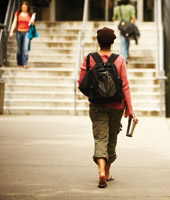 |
|
Autumn 2007 | Volume 30, Number 2
| Campus
|
|
|
Record Freshman Class Reflects
SPU’s Vision
A high-energy beginning

The 2007–08 freshman class has more ethnic diversity, more men, and more students interested in studying the sciences. |
The largest and most ethnically diverse freshman class contributed to Autumn Quarter’s high-energy opening at Seattle Pacific University on September 24, 2007. “I love that energy,” said SPU President Philip Eaton at his annual State of the University Address on the eve of New Student Orientation. “This is a precious gift that new students and their families are giving us. The word is out that SPU is the place to come.”
The growth, academic quality, and makeup of the freshman class is the result of Seattle Pacific’s institutional priorities and a steadily increasing application pool, up 3 percent from last year. “SPU’s vision to engage the culture and change the world is resonating
with students,” explains Jobe Korb-Nice, director of undergraduate admissions. “They do their research to find out what SPU is all about — because they have a strong idea of what they want to do with the rest of their lives, and they know what university they select matters.”
The University’s total enrollment is 3,842, including 3,038 undergraduates, which reflects SPU’s capacity undergraduate enrollment and is in keeping with its 10-year strategic plan. The record number of 939 new students is made up of 716 freshmen and 223 transfers.
Seattle Pacific also saw the continuation of some significant, recent enrollment trends. The four-year graduation rate jumped by eight points to 57 percent for the cohort that began as freshmen in 2003, largely due to the academic quality and preparedness of that class. This year’s freshmen generally exhibit the same level of academic strength and, because they are part of a larger class, replace the higher number of students who graduated in 2007.
SPU is also in its second decade of institutional investment in the sciences, and this fall 156 freshmen and transfer students enrolled in “PPHS 1200,” an orientation to the pre-professional health science track. Additionally,
like most universities across the United States, SPU has long had more female than male students. This year, however, the number of male freshmen grew by 7 percent.
Perhaps most significant of all, 20 percent of SPU’s new students come from ethnically diverse backgrounds — a jump from 13 percent in 2006 and 11 percent in 2005. “This growth is directly due to the institutional
priority SPU has placed on reconciliation and the diversification of our student body,” says Korb-Nice. That priority is embraced campus-wide, including by Undergraduate Admissions efforts; the Ames Scholarship program; and the Perkins Center for Reconciliation, Leadership Training, and Community Development.
“Many SPU departments and leaders have worked together to see all God’s children flourish and to do so by attracting the best
and brightest from every possible community,” says Tali Hairston, director of the Perkins Center. “We could not do this without our partners and friends who also believe that the Christian community should be about the work of reconciliation.”
With a new academic year underway, nine undergraduate admissions counselors have already fanned out across the United States, visiting college fairs and high schools in 18 states, such as California, Idaho, Colorado, Minnesota, New York, and Pennsylvania. In all, they’ll fly about 44,000 miles and drive another 17,000 miles as they tell the stories of Seattle Pacific students and alumni who are engaging the culture and changing the world.
Back to the top
Back to Campus Home
|
| |
|
 |
|
 |